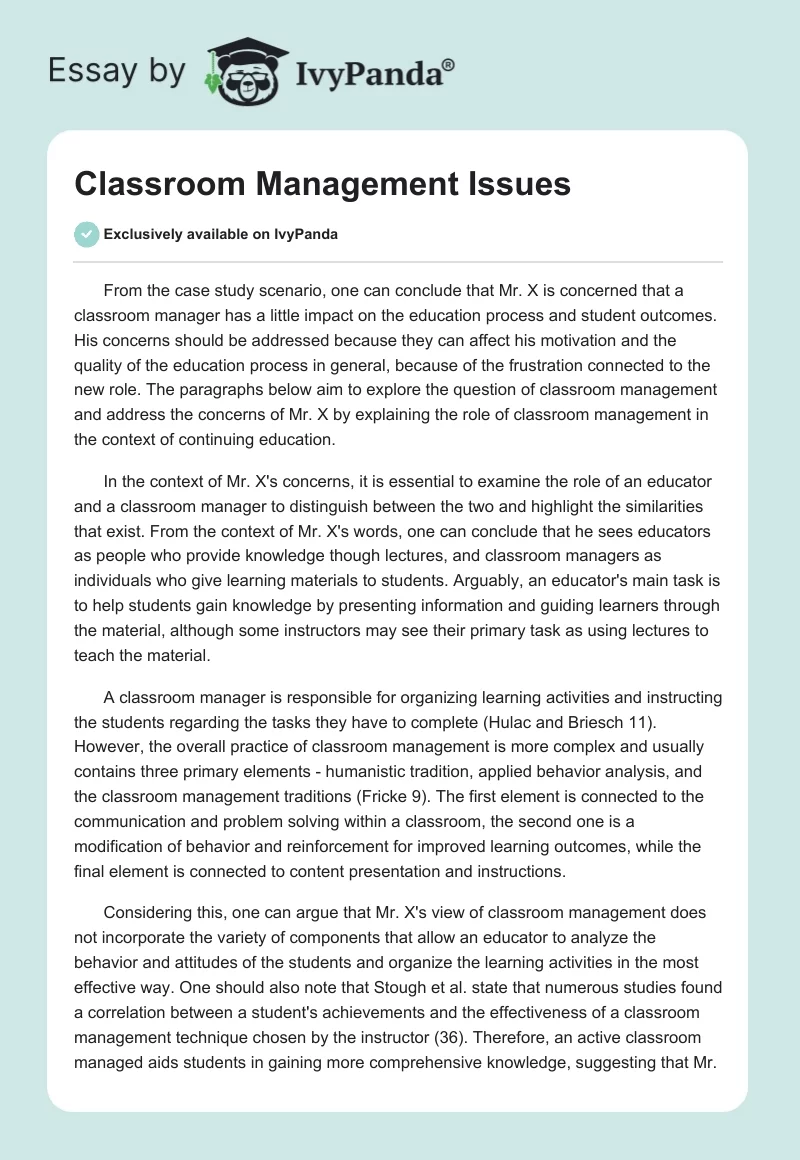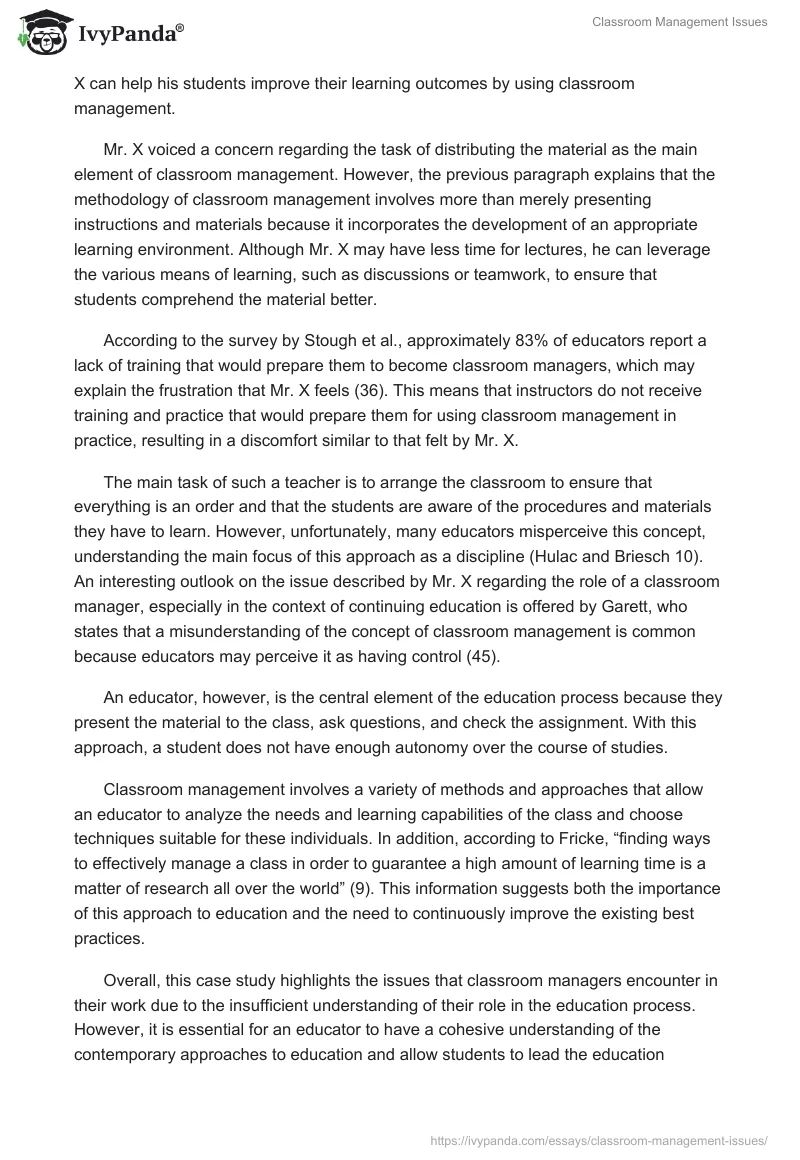From the case study scenario, one can conclude that Mr. X is concerned that a classroom manager has a little impact on the education process and student outcomes. His concerns should be addressed because they can affect his motivation and the quality of the education process in general, because of the frustration connected to the new role. The paragraphs below aim to explore the question of classroom management and address the concerns of Mr. X by explaining the role of classroom management in the context of continuing education.
In the context of Mr. X’s concerns, it is essential to examine the role of an educator and a classroom manager to distinguish between the two and highlight the similarities that exist. From the context of Mr. X’s words, one can conclude that he sees educators as people who provide knowledge though lectures, and classroom managers as individuals who give learning materials to students. Arguably, an educator’s main task is to help students gain knowledge by presenting information and guiding learners through the material, although some instructors may see their primary task as using lectures to teach the material.
A classroom manager is responsible for organizing learning activities and instructing the students regarding the tasks they have to complete (Hulac and Briesch 11). However, the overall practice of classroom management is more complex and usually contains three primary elements – humanistic tradition, applied behavior analysis, and the classroom management traditions (Fricke 9). The first element is connected to the communication and problem solving within a classroom, the second one is a modification of behavior and reinforcement for improved learning outcomes, while the final element is connected to content presentation and instructions.
Considering this, one can argue that Mr. X’s view of classroom management does not incorporate the variety of components that allow an educator to analyze the behavior and attitudes of the students and organize the learning activities in the most effective way. One should also note that Stough et al. state that numerous studies found a correlation between a student’s achievements and the effectiveness of a classroom management technique chosen by the instructor (36). Therefore, an active classroom managed aids students in gaining more comprehensive knowledge, suggesting that Mr. X can help his students improve their learning outcomes by using classroom management.
Mr. X voiced a concern regarding the task of distributing the material as the main element of classroom management. However, the previous paragraph explains that the methodology of classroom management involves more than merely presenting instructions and materials because it incorporates the development of an appropriate learning environment. Although Mr. X may have less time for lectures, he can leverage the various means of learning, such as discussions or teamwork, to ensure that students comprehend the material better.
According to the survey by Stough et al., approximately 83% of educators report a lack of training that would prepare them to become classroom managers, which may explain the frustration that Mr. X feels (36). This means that instructors do not receive training and practice that would prepare them for using classroom management in practice, resulting in a discomfort similar to that felt by Mr. X.
The main task of such a teacher is to arrange the classroom to ensure that everything is an order and that the students are aware of the procedures and materials they have to learn. However, unfortunately, many educators misperceive this concept, understanding the main focus of this approach as a discipline (Hulac and Briesch 10). An interesting outlook on the issue described by Mr. X regarding the role of a classroom manager, especially in the context of continuing education is offered by Garett, who states that a misunderstanding of the concept of classroom management is common because educators may perceive it as having control (45).
An educator, however, is the central element of the education process because they present the material to the class, ask questions, and check the assignment. With this approach, a student does not have enough autonomy over the course of studies.
Classroom management involves a variety of methods and approaches that allow an educator to analyze the needs and learning capabilities of the class and choose techniques suitable for these individuals. In addition, according to Fricke, “finding ways to effectively manage a class in order to guarantee a high amount of learning time is a matter of research all over the world” (9). This information suggests both the importance of this approach to education and the need to continuously improve the existing best practices.
Overall, this case study highlights the issues that classroom managers encounter in their work due to the insufficient understanding of their role in the education process. However, it is essential for an educator to have a cohesive understanding of the contemporary approaches to education and allow students to lead the education process. Therefore, the answers that Mr. X. should receive to allay his discomfort include the diversity of classroom management techniques and strategies and the lack of adequate guidelines, leading to concerns from many educators.
Assignment #2
New educators or neophytes may struggle with determining their professional identity and establishing themselves as a faculty member. An assessment of classroom management’s best practices suggests that Mr. X successfully applied this methodology during his lecture and created a positive learning environment for students encouraging behavior that aids learning. The following paragraphs will focus on examining the approach taken by Mr. X to evaluate the evidence suggesting that he managed the class.
In order to identify the evidence suggesting that Mr. X managed the class, it is necessary to examine the definition of classroom management and the main elements of it. Classroom management encompasses different approaches and techniques that teachers use to help students engage in the learning process. Arguably, Mr. X’s lecture focused on providing students with an opportunity to take part in different forms of learning new material, such as role-play and discussions. According to Stough et al., one of the models that describe classroom management is titled “Judicious Discipline” model, and it implies that an educator manages the behavior of the group (36).
As such, the focus on the interactionalist approach implies that the educator creates an environment where the students develop behavior systems that allow them to adjust their behavior for adequate learning. In the case of Mr. X, the students were provided with a lot of autonomy during the lecture. However, they were not passively listening, as the educator included several activities, such as a discussion and group work, allowing these individuals to be engaged in the process and learn best practices of education.
Mr. X ended the lecture by discussing the main aspects of the concepts that were defined during the lesson and by assessing feedback from students about the approaches he used during the lesson. This is an essential element of classroom management that teaches individuals to evaluate information and methodologies critically, as well as to learn about their personal preferred style of learning. According to Sharma, “the purpose of education is not just making a student literate but also adds rationale thinking, knowledgeably and self-sufficiency” (1). Through feedback assessment, Mr. X was able to address the mentioned elements of education.
The purpose of classroom management is to provide individuals with an ability to engage in the process of learning, instead of merely listening to a lecture or looking through the materials. Sharma cites active learning and the use of multimedia as a vital component of modern classroom management (1).
In this context, Mr. X successfully addressed the two domains since he showed students a video as an introduction to the topic. Sharma argues that this is a problem-solving method designed to help students develop a new set of skills by viewing multimedia materials (1). Additionally, the process of active learning implies that students collaborate and discuss the topic for better learning outcomes. Mr. X employed this technique several times because he invited students for a discussion of the topic and offered them a role play game and group work. Due to the fact that these were non-traditional learning approaches, one can argue that Mr. X managed the class.
Over the course of the lesson, Mr. X employed several different techniques and approaches, including digital content, discussions, and group work, that allowed the class to learn the material from different sources. This is consistent with Kohn’s theory of Student Directed Learning developed in 2006, which suggests that extrinsic motivation is ineffective, and instead, teachers should encourage the intrinsic curiosity of students (Understanding Three Key Classroom Management Theories).
One of the ways to leverage Kohn’s approach is to use multiple activities with different structures. Mr. X successfully employed this since the entire lecture consisted of different tasks. In such an environment, students exchange ideas on the topic and aim to explore the elements of it that are of the most interest to them (Understanding Three Key Classroom Management Theories). Moreover, they learn how to apply the examined concepts in their clinical practice, which is essential and was facilitated by the final discussion of the practical implications.
Classroom management is more complicated than traditional approaches to educating students, as one can see by examining the example of Mr. X. This method requires “creating active, relevant learning experiences that enable students to demonstrate mastery and success” (Understanding Three Key Classroom Management Theories). Since Mr. X continuously offered students new activities and employed different learning techniques, it can be argued that he successfully applied classroom management.
Overall, Mr. X successfully managed the class despite being a neophyte and having anxiety about his professional performance as an educator. The evidence that supports this conclusion includes the definition of classroom management as the use of different techniques that help create an appropriate environment for learning. Additionally, this educator leveraged the benefits of “Judicious Discipline” model, by guiding the students through the process of discussing the topic and working in collaboration with others.
Works Cited
Garrett, Tracy. “Misconceptions and goals of classroom management.” The Education Digest, vol. 5, no. 5, 2015, pp. 45-49.
Hulac, David Amy Briesch. Evidence-Based Strategies for Effective Classroom Management. The Guilford Press, 2017.
Fricke, Katharina. Classroom Management and Its Impact on Lesson Outcomes in Physics: A Multi-perspective Comparison of Teaching Practices in Primary and Secondary Schools. Logos Verlag Berlin, 2016.
Sharma, Rajesh. “Emerging Innovative Teaching Strategies in Nursing.” JOJ Nurse Health Care, vol. 1, no. 2, 2017, pp. 1-3.
Stough, Laura et al. “Persistent Classroom Management Training Needs of Experienced Teachers.” Journal of the Scholarship of Teaching and Learning, vol. 15, no. 5, 2015, pp. 36-48.
“Understanding Three Key Classroom Management Theories.” Husson University. Web.


